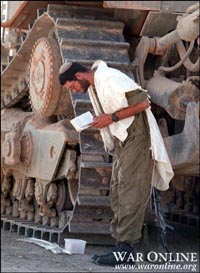transport
Objects in the Mirror

“A Palestinian threw a rock at an Israeli army bulldozer.”
This photo from Abid Katib/Getty Images appeared on the front page of today’s New York Times online. The image and caption linked to the article Israeli Tanks Enter Gaza; 4 Palestinians Die in Fighting.
In the photo, the Palestinian looms large above the bulldozer. He is a lanky, but determined and formidable force — a dark, faceless enemy poised to smash the small, apparently unarmed machine. The force of his attack is accented by patterns in the clouds, and exaggerated by the tilt of the camera (note the horizon line.) The bulldozer does not seem to be attacking the Palestinian or doing anything other than driving by, going about its business. The article reinforces this, making no mention of the purpose of the bulldozer or why it would need an escort of tanks.
From the photo, you’d have no idea that the bulldozer is 13 feet tall and well protected against his rock.
See the entry on the Caterpillar D9 from wikipedia.org:
“Armored bulldozers are a standard tool of Combat engineering battalions, and the IDF has gained some notoriety for their use of armored tractors in the Al-Aqsa Intifada, Operation Defensive Shield, and their involvement in the demolition of orchards and residences and the consequential death of [U.S. college student] Rachel Corrie....
The operator is protected by bulletproof glass to protect against bombs, machinegun and sniper fire. The fitted armor package adds roughly 10 additional tons to the weight to a so-equipped D9. Like many customized packages, individually modified D9s may be found with disparate features, such as crew-operated machine guns, smoke projectors, or grenade launchers....
The Israeli armor kit proved itself well, as no D9 operator was killed during the 3-year long al-Aqsa Intifada.”
The U.S.-based Caterpillar Corporation manufactures the D9. The Israeli Defence Force developed the armor kit. Last year, Israel’s Technion Institute of Technology, announced a remote controlled version of the D9.
The Israeli Committee Against House Demolitions reports that the IDF has demolished over 10,000 houses in the Occupied Territories since 1967. The Caterpillar D9 was used to demolish an entire neighborhood in the Jenin refugee camp in April 2002.
Other photos show a very different scale:
For more information, see Stop Caterpillar, a campaign to hold the Caterpillar Corporation accountable for the criminal use of its products by the Israeli army.
Road Kill
Courtesy of Ken Avidor:
 “Highway expansion in America is big business. The Highway Expansionists enjoys the support of both Democrats and Republicans and sometimes Greens. Millions of dollars are spent on propaganda to support the notion that the destruction of the People Zone for the Auto Zone is an inevitable and desirable part of “Progress.” If you add the billions of dollars the auto and oil industry spends on advertising and public relations, it is no wonder that opponents of highway expansion face a public wall of apathy and suspicion. It is not easy to break through that wall of conditioning. Words alone cannot correct the positve mental images people have of automobiles and highways from acquired from a lifetime of viewing TV commercials.
“Highway expansion in America is big business. The Highway Expansionists enjoys the support of both Democrats and Republicans and sometimes Greens. Millions of dollars are spent on propaganda to support the notion that the destruction of the People Zone for the Auto Zone is an inevitable and desirable part of “Progress.” If you add the billions of dollars the auto and oil industry spends on advertising and public relations, it is no wonder that opponents of highway expansion face a public wall of apathy and suspicion. It is not easy to break through that wall of conditioning. Words alone cannot correct the positve mental images people have of automobiles and highways from acquired from a lifetime of viewing TV commercials.
STRIDE (Southside Traffic Reduction Initiative to Determine our Environment) uses photos, art and comics on its website to counter the industry PR images. Comics and satire are also a fun way to convey complex ideas. They can also attract attention to more serious stuff. We are hoping to add music and animation to the STRIDE site in the near future.
These are some sites that have art and comics against highway expansion [in Minnesota]:
http://www.Stride-mn.org
http://www.roadkillbill.com
http://www.andysinger.com
http://www.carbusters.org/
Toll
Reading the catalog for Me, Myself, and Infrastructure, I stumble onto this:
“The corporations with the highest revenues in the U.S. are Wal-Mart, Exxon Mobil, General Motors, and Ford. They base their business on the supremacy of the road in American life.”
Wow! Incredulous, I consult Google. It’s true. Sometimes, living blissfully without a car in New York City, one forgets how the rest of this enormous country lives.
But then, via Planetizen my revelation is adjusted again. Sprawl is not propelled simply by consumer demand, but by lobbyists and politics that protect and promote the interests of those same companies.
Serve and Protect
From AP, August 26, 2002:
Florida police cars to sport corporate logos
“SPRINGFIELD, Fla. — This Florida Panhandle town is getting new police cars for only $1 each, but there’s a catch. The cars will be festooned with corporate sponsorship logos similar to those on race cars.
City commissioners voted 4-0 Thursday to accept the deal with Charlotte, N.C.-based Government Acquisitions. The company hopes to provide a new squad car for each of Springfield’s 15 officers within the next three years.
Government Acquisitions partner Ken Allison said advertising on cruisers destined for the Panama City suburb would be toned down.
Police Chief Sam Slay said the city could save about $500,000 over the three-year span.
‘You are talking about $500,000 that can be spent other places in the city, and that’s what this program is for,’ said Mayor Robert Walker.
Slay wants the savings used to hire two more officers, but Commissioner Carl Curti said other departments may need the money. Slay said his department should get to keep use the money instead of being punished for saving it.
Curti also was apprehensive about using the police car budget for other purposes.
‘These free cars may not always be free cars,’ Curti said.”
At Least the Trains Ran on Time
From snopes:
“One of the best ways to gain the support of the people you want to lead is to do something of benefit to them. Failing that, the next best thing is to convince them that you have done something of benefit to them, even though you really haven’t. So it was with Benito Mussolini and the Italian railway system.
 After the ‘march on Rome’ (which was itself a myth of fascist propaganda) on 28 October 1922 that resulted in King Vittorio Emanuele’s appointment of Benito Mussolini as prime minister and the accession to power of the fascists in Italy, Mussolini needed to convince the people of Italy that fascism was indeed a system that worked to their benefit. Thus was born the myth of fascist efficiency, with the train as its symbol. The word was spread that Mussolini had turned the dilapidated Italian railway system into one that was the envy of all Europe, featuring trains that were both dependable and punctual. In Mussolini’s Italy, all the trains ran on time.
After the ‘march on Rome’ (which was itself a myth of fascist propaganda) on 28 October 1922 that resulted in King Vittorio Emanuele’s appointment of Benito Mussolini as prime minister and the accession to power of the fascists in Italy, Mussolini needed to convince the people of Italy that fascism was indeed a system that worked to their benefit. Thus was born the myth of fascist efficiency, with the train as its symbol. The word was spread that Mussolini had turned the dilapidated Italian railway system into one that was the envy of all Europe, featuring trains that were both dependable and punctual. In Mussolini’s Italy, all the trains ran on time.
Well, not quite. The Italian railway system had fallen into a rather sad state during World War I, and it did improve a good deal during the 1920s, but Mussolini was disingenuous in taking credit for the changes: much of the repair work had been performed before Mussolini and the fascists came to power in 1922. More importantly (to the claim at hand), those who actually lived in Italy during the Mussolini era have borne testimony that the Italian railway’s legendary adherence to timetables was far more myth than reality.
The myth of Mussolini’s punctual trains lives on, albeit with a different slant: rather than serving as a fictitious symbol of the benefits of fascism, it is now offered as a sardonic example that something good can result even from the worst of circumstances. As Montagu and Darling wrote:
‘Mussolini may have done many brutal and tyrannical things; he may have destroyed human freedom in Italy; he may have murdered and tortured citizens whose only crime was to oppose Mussolini; but “one had to admit” one thing about the Dictator: he “made the trains run on time.”’”
Where the Sidewalk Ends
A paper in the September issue of the American Journal of Public Health, “Promoting Safe Walking and Cycling to Improve Public Health: Lessons From The Netherlands and Germany” by a couple of researchers in New Jersey and Brussels examines:
“The public health consequences of unsafe and inconvenient walking and bicycling conditions in American cities to suggest improvements based on successful policies in The Netherlands and Germany.”
What they found:
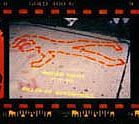 “Cyclists and pedestrians in the United States were two to six times more likely to be killed than their German or Dutch counterparts. Per kilometer traveled, U.S. pedestrians were 23 times more likely to get killed than the occupants of a car, while bicyclists were 12 times more likely to be killed.” [source]
“Cyclists and pedestrians in the United States were two to six times more likely to be killed than their German or Dutch counterparts. Per kilometer traveled, U.S. pedestrians were 23 times more likely to get killed than the occupants of a car, while bicyclists were 12 times more likely to be killed.” [source]
With this in mind and my previous post on the link between sprawl and obesity, I note that on July 24, the House Appropriations Committee voted a transportation appropriations bill out of committee that eliminates funding for the Transportation Enhancements program.
Since 1991, 10% of federal funds distributed to states through the Surface Transportation Program has been reserved for transportation enhancement activities. This meant roughly $600 million a year of federal funding for locally driven, pedestrian centered projects.
“Congress established the TE program in 1991 as a commitment by Congress to constituents that a small percentage of their gas tax dollars would be targeted to small-scale, community-initiated, locally selected transportation projects such as multi-use paths, pedestrian and bicycle facilities, historic preservation, and improvement of streetscapes and landscapes.” [source]
“Since its inception, the TE program has provided $6 billion to support 16,699 projects nationwide, including thousands of historic preservation projects. Now, Congress is acting to reverse this decade-long community building program and return to a regressive ‘roads-only’ policy.” [source]
The Rails-to-Trails Conservancy has posted a detailed state-level breakdown of projects funded under Transportation Enhancements program.
H.R. 2989, the Transportation and Treasury Appropriations Bill for 2004, actually increases highway spending to $34.1 billion — $6.1 billion more than 2003 and $4.5 billion more than President Bush’s request.
There is still hope, but we must act now. Before the full House votes on the bill it can still be amended. Congress resumes after Labor Day and is expected to vote on the bill in early September.
An amendment removing section 114 from H.R. 2989 would grant approximately $812 million to the Transportation Enhancements program. Unless reversed, individual states would be allowed to put all funds into highway projects instead of setting aside the 10% now reserved for bicycle and pedestrian projects.
See these action alerts to learn more, for contact information and talking points.
With all that’s going on, the issue is probably not high on everyone’s social justice agenda. But there’s an immediate and brief opportunity to save this great program right now.
UPDATE: On September 4 the House approved an amendment which strikes section 114 from the bill — restoring funding for the Transportation Enhancements program to the appropriations bill. On September 9, the House passed the full appropriations bill and sent it to the Senate. Thanks to everyone for taking action!
Sprawl Linked to Obesity
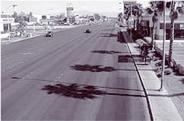 From the press release:
From the press release:
“A new national study and special issues of two prestigious medical journals released today offer powerful indications that sprawling development has a hand in the country’s obesity crisis. Together, they demonstrate the urgent need to invest in making America’s neighborhoods appealing and safe places to walk and bicycle. The peer-reviewed study, which used a county sprawl index developed in partnership with Smart Growth America, found that people living in automobile-dependent neighborhoods that suppress walking do indeed walk less, weigh more, and are more likely to suffer from high blood pressure. The study, Relationship between Urban Sprawl and Physical Activity, Obesity, and Morbidity is being published in a special issue of the American Journal of Health Promotion. Smart Growth America and the Surface Transportation Policy Project have issued a companion report, Measuring the Health Effects of Sprawl, which gives county-level data illustrating the findings for the metropolitan areas studied. In most metropolitan areas, residents in more sprawling counties are heavier and face higher odds of being obese and having high blood pressure than those in less sprawling counties... The report outlines seven steps communities can take to respond to the findings of the research.”
The paper was presented at the 11th annual Congress for the New Urbanism, an organization that pushes for all new development in the United States to be more compact and walkable.
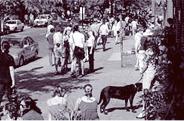 The metropolitan sprawl index:
The metropolitan sprawl index:
“uses 22 variables to characterize four ‘factors’ of sprawl for 83 of the largest metropolitan area in the US for the year 2000. The sprawl ‘scores’ for each metropolitan area show how much they spread out housing, segregate homes from other places, have only weak centers of activity, and have poorly connected street networks.... The county sprawl index uses six variables from the US Census and the Department of Agriculture’s Natural Resources Inventory to account for residential density and street accessibility.”
The sprawl index of 448 counties was compared to body mass index and data on average weight drawn from the Centers for Disease Control and Prevention.
Research into other factors, such as linking location to what and how much people eat, and analysis at the neighborhood level is forthcoming.
Obesity in the United States is at an all time high. More than two-thirds of adults are overweight and nearly 1 in 3 are obese. Obesity is rapidly catching up to tobacco use as the leading cause of death. [source]
via Planetizen
Architecture of Segregation
Chicken&Egg Public Projects “conceives and develops interpretive environments and interactive strategies that advance public understanding of cultural and social issues.”
“Architecture of Segregation explores how racial attitudes shaped urban, suburban, and rural landscapes that maintain divisions in American society. This multidisciplinary project examines the ways in which forces ranging from violent individuals to institutional practice to government policy embedded racial biases in everyday spaces, places, and structures during the second half of the twentieth century. Through collaboration with a network of scholars and institutions, Architecture of Segregation will comprise a major publication, national traveling exhibition, web site, and educational activities. These products, conceived to engage a broad audience, are intended as a stimulus for public discussion, continued scholarly research, and new directions in public policy.
The Supreme Court’s 1896 approval of separate and ‘equal’ facilities for blacks and whites permitted Americans to build an exclusionary, unequal society. The Civil Rights, Voting Rights, and Fair Housing Acts of the 1960s gave hope but did not lead to the dismantling of the architecture of segregation. Today, Americans do not realize how decisively discriminatory motives guided the construction of everyday landscapes. Scholars in many disciplines have examined segregation but have not provided a broad view of its physical structure, from housing to highways.
 Architecture of Segregation asks: How have racial attitudes shaped the built environment? What are the structures of a closed society? How do these keep races apart, even in the absence of prejudice? Architecture of Segregation will encourage the general public, scholars, policy makers, and the media to consider these questions as they reexamine the twentieth-century construction of the American home. By concentrating on familiar spaces and activities, it will encourage the public to understand the forces that shaped the landscape and to recognize how that landscape shapes their behavior and beliefs. With this understanding, they can consider rebuilding a divided United States....
Architecture of Segregation asks: How have racial attitudes shaped the built environment? What are the structures of a closed society? How do these keep races apart, even in the absence of prejudice? Architecture of Segregation will encourage the general public, scholars, policy makers, and the media to consider these questions as they reexamine the twentieth-century construction of the American home. By concentrating on familiar spaces and activities, it will encourage the public to understand the forces that shaped the landscape and to recognize how that landscape shapes their behavior and beliefs. With this understanding, they can consider rebuilding a divided United States....
A book, published by The New Press, will take a geographically diverse, cradle-to-grave look at black and white worlds. Essays will be written by leading scholars, such as Jacqueline Jones on work in the rural south, Raymond Mohl on the interstate highway system, and Gwendolyn Wright on housing. Contributors include Mindy Fullilove (birth), Waldo Martin (education), Lise Funderburg (neighborhood), Maurice Berger (leisure), June Manning Thomas (worship), and John Vlach (death). The Graham Foundation has provided a grant to support publication.
A national traveling exhibition is scheduled to open in 2004 at the National Building Museum in Washington, D.C., which is producing the project in conjunction with Chicken&Egg Public Projects, Curatorial Assistance Traveling Exhibitions, and a planned consortium of museums in New York, Boston, Atlanta, Chicago, Houston, Minneapolis, and San Francisco or Los Angeles. Using powerful visual media within a striking spatial configuration, it will include artifacts, photographs, and artworks representing white and black environments from all regions of the United States. The exhibition will serve as a springboard for public programs, including discussions, lectures, workshops, tours, and film series. Architecture of Segregation will engage the public in an exploration of the relationship between race and place in the United States.”
I wonder how the exhibition organizers are working with groups engaged in current struggles, and how those groups can use the event to build some public pressure.
Redesigning the High Line
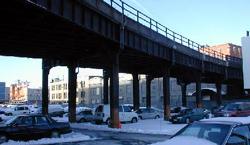

“Designing the High Line” is an exhibition of ideas for the conversion of the High Line elevated rail structure to public space. The exhibit is showing in Grand Central Terminal until July 26. 720 entries were submitted from 36 countries. More than 100 of the proposals, including the competition winners, are displayed in the Grand Central exhibit. All 720 entries are displayed on the Web site.
In addition to the four principal winners, designs were selected for special cash awards for depicting the most compelling solution for universal access to the elevated structure, and for incorporating plants and wild flowers native to New York. (Pictures are posted here and here, though difficult to read.)
The High Line runs for 1.45 miles over Manhattan’s West Side, from 34th Street down through Chelsea to Gansevoort Street in the Meat Packing District. The High Line was built during one of New York City’s largest infrastructure projects, the West Side Improvement project. The project took place in the early 1930’s during the Great Depression and was presided over by Robert Moses. The Line carried freight above the streets of the West Side until 1980, when the last boxcars hauled a load of frozen turkeys down the tracks. The structure has been inactive since, collecting trash, shedding rust, and sprouting an elevated garden of weeds and wildflowers. [more history here]
In 1992, the Chelsea Property Owners, a coalition of two dozen businesses who own property under and near the Line — mostly parking lots, machine shops, warehouses, and the trendy Chelsea Market — won a conditional demolition order from the Surface Transportation Board. The proposal to tear down the Line was later supported by Mayor Giuliani. The plan never materialized because the coalition and the railroad’s owner at the time, Conrail, could not agree on an ultimate price tag for demolition. [source]
Through the economic boom of the 90’s, however, new residents moved into the neighborhoods below the Line, among them artists, designers, and galleries. In 1999, an altogether different group of neighborhood residents founded Friends of the High Line, a 501(c)(3) non-profit organization with the mission of converting the structure to an elevated public space.
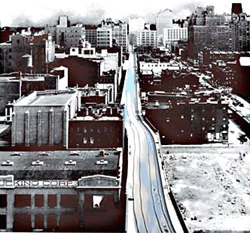 And, after much lobbying, it looks like the High Line might actually be redesigned. At the July 9 benefit preview of the exhibition, New York City Council Speaker Gifford Miller announced a $15.75 million funding commitment for planning and construction. The first $750,000 was allocated in the budget adopted by the New York City Council on June 27.
And, after much lobbying, it looks like the High Line might actually be redesigned. At the July 9 benefit preview of the exhibition, New York City Council Speaker Gifford Miller announced a $15.75 million funding commitment for planning and construction. The first $750,000 was allocated in the budget adopted by the New York City Council on June 27.
“The funds can be used for planning, design, and construction costs related to the High Line project during the fiscal year that began July 1. The remainder of the $15.75 million commitment will be allocated to the High Line in the following three fiscal years.
‘The High Line was built during the Depression to invigorate New York’s economy, and it will reinvigorate our City again today,’ said Speaker Miller. ‘As we have learned from our City’s great parks, public spaces create value and catalyze growth. Central Park was planned in a recession. Even in tough economic times, we have to invest in our future—by planning for the public projects that will keep us at the forefront of the world’s great cities.’
The funds will come from the City’s capital budget, which pays for project costs such as planning, design, construction, and long-term leases. The allocation will not affect municipal services, which are funded separately through the City’s expense budget.” [source]
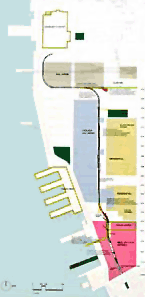 The Friends of the High Line are also seeking private, corporate, foundation, and federal funds for the project.
The Friends of the High Line are also seeking private, corporate, foundation, and federal funds for the project.
The competition follows two detailed planning studies: Reclaiming the High Line, sponsored by Friends of the High Line and the Design Trust for Public Space; and a comprehensive economic feasibility study, commissioned at the City’s request.
In December 2002, the City of New York took the first step in converting the High Line to a public walkway through federal rails-to-trails legislation. FHL is currently waiting on decision before Federal surface transportation board to allow City to move forward.
“As the next phase in its project to preserve and re-use the High Line, Friends of the High Line will hold a series of open workshops with members of the community beginning in September, with a variety of the competition proposals serving as springboards for discussion. At the end of 2003, Friends of the High Line will incorporate the community’s comments into a Request for Proposals, which will lead to the development of realizable designs.” [source]
The High Line is currently private property, owned by the rail company CSX Corporation. CSX acquired the High Line when it purchased Conrail in 1997. Conrail was created by the federal government in 1970’s from the remains of the New York Central and other railroads bankrupted by “competition from trucks, subsidized by the federally-built Interstate highway system, and an archiac system of economic regulations which prevented railroads from responding to the needs of the market.” The corporation was sold to the public in 1987, in what was then the nation’s biggest IPO. [more on Conrail] Though the High Line is private property, the federal government, specifically the Surface Transportation Board, has control over the Line as a piece of the nation’s rail infrastructure. CSX has been ordered by the government to work with all interested parties to effect the best exit strategy for the High Line, and to remain neutral as to the High Line’s outcome.
The City can not afford to purchase land under High Line, so has instead proposed rezoning and property transfer, moving air and development rights out to sites around West Chelsea. One potential consequence would be a wall of huge residential towers springing up along 10th and 11th Avenues in otherwise moderately sized manufacturing and retail zones. One challenge faced by city planners is the prevention such “massing.”
The High Line snakes through many neighborhoods and buildings, but sits almost entirely within the area served by Manhattan Community Board No. 4. The current Line blocks sunlight, collects trash, and drops water, rust, and pigeon droppings on the streets below. However, according to a survey by the Board, most community residents support conversion over demolition. They want to make sure, though, that the results of the redesign are the best damn park possible. The community is wary of new large-scale structures or billboards that would block sight of or access to the Hudson River. The project should provide open space for cultural programing, be accessible, and safe, providing a way to get up or down quickly. But most of all, it should connect with and respect the community. Some residential buildings sit within 5 feet of Line.
As development proceeds, areas beneath and adjacent to High Line will become lucrative spots for retail. Indeed, represenatives of our businessman-turned-Mayor is keen to move some of that retail up onto High Line itself. Other possibilities include constructing adjacent buildings with roof access that would meet the High Line or produce huge urban stairs, parks that terrace up to the bed of High Line, which is about 30 feet from the ground.
At a panel discussion, I asked Robert Hammond, co-founder of Friends of the High Line, about their advocacy strategy and how design competition fits into it. The competition took a year to organize from beginning to end and was a way to get people excited, to generate activism and support, and to provide a public platform for discussion. He noted the power of crazy, weird ideas - and how it is often easier to draw attention and support for the crazy ideas than the conservative plans. Another panelist noted that, when not located to a specific neighborhood, the constituency of public open space is transient and often does not have a consistent voice. The competition was an opportunity “to get those ideas out there.” Over the years, many have developed redesigns of the High Line for their thesis projects.
I asked Mr. Hammond what has led to their success to date while civic budgets are being cut and other projects around the city have faltered. Mr. Hammond proposed that the support base was “not the usual mix of neighborhood advocates.... The strongest supporters are architects, artists, art dealers.” Indeed a list of supporters at the gala benefit includes many A-list authors, actors, and artists. Not your usual city planning scene.
Mr. Hammond also noted that the design of their campaign materials was also key. Several designers have donated services to develop graphically sophisticated materials. Brochures, Web site, postcards for public comment... “Everything produced looks interesting. It suggests that the final design will be as innovative.”
Ironically, development of the High Line may push many in the arts community to leave the area. When the project is complete, rents around the Line are likely to increase. Many arts spaces are already midway through their 10 year lease, and unable to afford the current market rents. Part of the development plans could create public spaces that would not command retail rents and could support galleries, though these would be limited.
So how will the crazy ideas not get lost, or bogged down by politics? And allow ultimate designer to maintain poetic vision? The challenge is yet to come. Once New York realizes that the project is possible, everyone will want a piece of the action. It will be important to maintain a clear vision, and to make sure the final product is as extraordinary, interesting, and strange as the High Line itself.
Check out these photo galleries on the current state of the High Line.
The High Line was mentioned here in one of my first blog posts.
ISO
 The International Organization for Standardization is an international non-governmental organization that coordinates the development of voluntary technical standards.
The International Organization for Standardization is an international non-governmental organization that coordinates the development of voluntary technical standards.
ISO is a network of the national standards institutes of 146 countries with a Central Secretariat in Geneva, Switzerland, that coordinates the system. National standards institutes, not governments themselves, are eligible for membership. Each country sends only one member, and each member has one vote.
The ISO does not regulate or legislate. It’s standards are developed by international consensus among “experts drawn from the industrial, technical and business sectors... experts from government, regulatory authorities, testing bodies, academia, consumer groups or other relevant bodies.”
“There are more than 2,850 of working groups in which some 30,000 experts participate annually. This technical work is coordinated from ISO Central Secretariat in Geneva, which also publishes the standards.
Since 1947, ISO has published more than 13,500 International Standards. ISO’s work programme ranges from standards for traditional activities, such as agriculture and construction, through mechanical engineering to the newest information technology developments, such as the digital coding of audio-visual signals for multimedia applications.
Standardization of screw threads helps to keep chairs, children’s bicycles and aircraft together and solves the repair and maintenance problems caused by a lack of standardization that were once a major headache for manufacturers and product users. Standards establishing an international consensus on terminology make technology transfer easier and can represent an important stage in the advancement of new technologies.
Without the standardized dimensions of freight containers, international trade would be slower and more expensive. Without the standardization of telephone and banking cards, life would be more complicated. A lack of standardization may even affect the quality of life itself: for the disabled, for example, when they are barred access to consumer products, public transport and buildings because the dimensions of wheelchairs and entrances are not standardized.
Standardized symbols provide danger warnings and information across linguistic frontiers. Consensus on grades of various materials give a common reference for suppliers and clients in business dealings.
Agreement on a sufficient number of variations of a product to meet most current applications allows economies of scale with cost benefits for both producers and consumers. An example is the standardization of paper sizes.” [source]
The internatinoal technical standards also include international safety standards for products including toys (ISO 8124-1:2000), camping tents (ISO 5912:1993), bicycles (ISO 4210:1996), and contraceptive devices (ISO 8009).
In 1987, the ISO expanded to develop “generic management system standards.” ISO 9000 is set of a quality management guidelines that apply to all kinds of organizations in all kinds of areas. Once the a quality system is in place, an accredited external auditor can certify that your quality system has met all of ISO’s requirements. They can then issue official certification that you can use to publicize that the quality of your products and services is managed, controlled, and assured by a registered ISO 9000 quality system.

 ISO 7001, “Graphical symbols for use on public information signs,” is a set of international symbols based on the “ISOTYPE” system of icons and pictograms introduced by Otto Neurath in the 1936. However, soon after the 7001 was published, it was determined that the standard international symbols did not have a standard meaning or clarity in every country. Published in 1989 and revised in 2001, ISO 9186 is a procedure for user testing of graphic symbols to determine which symbols communicate the intended meaning most readily to most people. There are two main test methods: a comprehensibility judgment test and a comprehension test. [source] Pictograms with exceptionally high comprehensibility in several countries can eventually become part of the ISO 7001 set.
ISO 7001, “Graphical symbols for use on public information signs,” is a set of international symbols based on the “ISOTYPE” system of icons and pictograms introduced by Otto Neurath in the 1936. However, soon after the 7001 was published, it was determined that the standard international symbols did not have a standard meaning or clarity in every country. Published in 1989 and revised in 2001, ISO 9186 is a procedure for user testing of graphic symbols to determine which symbols communicate the intended meaning most readily to most people. There are two main test methods: a comprehensibility judgment test and a comprehension test. [source] Pictograms with exceptionally high comprehensibility in several countries can eventually become part of the ISO 7001 set.
ISO 13407 “Human centred design processes for interactive systems” provide guidelines for the planning and management of usability testing in the development of computer systems.
In 1993, the ISO established a technical committee, ISO/TC 207 to develop standards for “Environmental management.”
“This move was a concrete manifestation of ISO’s commitment to respond to the complex challenge of “sustainable development” articulated at the 1992 United Nations Conference on Environment and Development in Rio de Janeiro. It also stemmed from an intensive consultation process, carried out within the framework of the Strategic Advisory Group on Environment (SAGE). SAGE was set up in 1991 and brought together representatives of a variety of countries and international organizations — a total of more than 100 environmental experts — who helped to define how International Standards could support better environmental management.
Today, national delegations of environmental experts from 66 countries participate within ISO/TC 207, including 27 developing countries. In addition, 35 international non-governmental and business organizations participate as liaison organizations. The national delegations are chosen by the national standards institute concerned and they are required to bring to ISO/TC 207 a national consensus on issues being addressed by the technical committee. This national consensus is derived from a process of consultation with interested parties in each country.” [source]
The committee works in hand with ISO/TC 176, which develops the ISO 9000 family of standards for quality management and quality assurance.
“ISO 14000 refers to a series of voluntary standards in the environmental field under development by ISO. Included in the ISO 14000 series are the ISO 14001 EMS Standard and other standards in fields such as environmental auditing, environmental performance evaluation, environmental labeling, and life-cycle assessment. The EMS and auditing standards are now final. The others are in various stages of development.” [source]
ISO 14001 certification remains valid for three years and requires audits performed at least annually.
While U.S. environmental regulations do not apply outside of U.S. territory, ISO 14001 applies to all of your operations:
“Perhaps the most significant factor accelerating ISO 14001 compliance is the ever-increasing globalization that characterizes the auto industry. More and more, auto manufacturing is mirroring airplane manufacturing: parts and components might be manufactured anywhere, and assembly might occur anywhere.
This means that a single automaker can have multiple facilities all over the world, under the same corporate umbrella, which require a consistent EMS and measurable results in order to operate competitively. ISO 14001 is one of the best ways to ensure that these needs are met.” [source]
UPDATE: See my August 5, 2003 blog post ISO 14001 Reconsidered.


